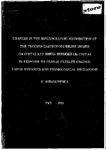Changes In the biogeographic distribution of the trochid gastropods Osilinus lineatus (da Costa) and Gibbula umbilicalis (da Costa) in response to global climate change: range dynamics and physiological mechanisms
| dc.contributor.author | MIESZKOWSKA, NOVA | |
| dc.contributor.other | Faculty of Science and Engineering | en_US |
| dc.date.accessioned | 2012-08-02T08:45:43Z | |
| dc.date.available | 2012-08-02T08:45:43Z | |
| dc.date.issued | 2005 | |
| dc.identifier | Not available | en_US |
| dc.identifier.uri | http://hdl.handle.net/10026.1/1072 | |
| dc.description.abstract |
There is an urgent need to understand the effects of climatic variability on species' distributions. This thesis uses an integrative approach to identify and explain the changes in geographical distribution of two rocky intertidal, warm water species of trochid gastropod, Osilinus lineatus (da Costa) and Gibbula umbiiicalis (da Costa) that have occurred since the onset of rapid climate warming in the mid-1980s. The potential physiological mechanisms causing the range shifts are examined, and the effects on population dynamics quantified. I resurveyed sites in Britain and northern France previously surveyed by Southward & Crisp (1950s), Hawthorne (1960s) and Kendall, Williamson & Lewis (1970s and 1980s) to record the current north and east distributional limits of Osilinus lineatus and Gibbula umbilicalis between 2002-2004. The range of O. lineatus had extended north by 100km and east by 55km since 1986, and G. umbilicalis had extended its northern limits by 85km since 1985. Concordant increases in abundance had occurred in both species across all quantitative survey sites between 1985/6 and 2002-2004. Studies of the effects of increased sea temperatures on gonad development and spawning were run concurrently in the field and the laboratory. The reproductive cycle occurred 2 months earlier in all field populations studied over a distance of 4° latitude during the warmer years of 2003 and 2004, compared to studies made in the cooler 1960s and 1980s. No gonad re-maturation was observed in field or laboratory populations. Analyses of 0, lineatus and G. umbilicalis population data from the 1970s, 1980s and 2000s showed that recruitment success had increased as winter sea temperatures had warmed. Field and laboratory studies of survival and growth of newly settled recruits was positively related to sea temperature, with greater survival at increased winter temperatures. Plasticity in the timing of the reproductive cycle and increased recruitment success in response to increased sea temperatures are suggested as the physiological mechanisms driving range extensions in O. lineatus and G. umbilicalis during the current period of rapid climate warming | en_US |
| dc.language.iso | en | en_US |
| dc.publisher | University of Plymouth | en_US |
| dc.title | Changes In the biogeographic distribution of the trochid gastropods Osilinus lineatus (da Costa) and Gibbula umbilicalis (da Costa) in response to global climate change: range dynamics and physiological mechanisms | en_US |
| dc.type | Thesis | |
| dc.identifier.doi | http://dx.doi.org/10.24382/3465 |
Files in this item
This item appears in the following Collection(s)
-
01 Research Theses Main Collection
Research Theses Main


